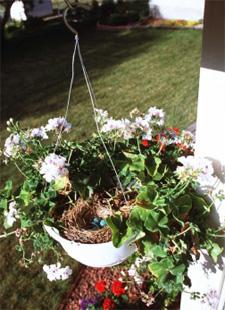Tips for Improving Backyard Habitat
In 12 Wildlife Habitat Tips for Small Acreages, learn what you can do to improve the area around your home for wildlife, whether your yard is a half acre or 40 acres.

Watching wildlife close to one's home is popular in Arkansas, with an estimated one of every three Arkansans.
When creating or enhancing habitat around your home, consider these questions.
Your answers will help determine the specific types of habitat that you need.
Read our additional article about the three Ds of backyard habitat and learn birdhouse basics from the University of Maine Extension Service.
Help us bring back bobwhites by downloading our bobwhite landowner's guide.
Many wildlife species rely on a diversity of habitat to survive. Variety is key to establishing good habitat. The more variety your yard or neighborhood can provide in a small area, the more wildlife you can expect to attract. Diversity includes providing all the habitat components that wildlife need in your yard - food, water, shelter, and nesting habitat.
Food sources. Food can be provided in a variety of ways. As you look around your property, think like the wildlife you want to attract. Is there enough food year-round to meet their needs? Are there flowers for nectar, weeds for seeds, shrubs and trees for fruit or acorns? Nectar plants, such as butterflyweed, butterfly bush, cardinal flowers, asters, and zinnias, attract butterflies and hummingbirds. Even "weeds" such as goldenrod, chicory, pokeweed, thistle, and honeysuckle are beneficial nectar producers. Clovers can provide sustenance for cottontails. Leaving leaves, mulching plants, using compost, and minimizing pesticide use benefits those wildlife species which rely on insects and invertebrates as food.
Water sources. Water is important for drinking, bathing, even egg-laying for frogs, toads, and insects. Water depth of 1/2" is needed for smaller birds, while larger birds can use 1" to 2" depth. Placement of feeders and water sources should be carefully considered, such that there is enough open space to see an approaching predator, yet protective habitat is available close by. Wildlife need water in the winter as well. Keep a piece of wood in the water to prevent freezing and thawing actions from cracking your birdbath or other water container.
Cover or shelter. In your yard, also consider that wildlife need shelter for protection against, rain, snow, ice, sun, wind, and predators. Dense evergreens, large broad-leaved shrubs and trees, thick grasses, and brushpiles provide protective cover for a number of birds and mammals. Mockingbirds build nests in shrubs, while barn swallows use barns, outbuildings, or open garages as places to construct their mud nests. You can expand your nesting habitat with artificial nest boxes for songbirds, bats, and owls. Several key factors make a good birdhouse. It should be built of wood, have an entry hole at least 6" above floor, have an overhanging roof to keep rain from the entrance, contain ventilation holes or slits, provide an easy way to open for cleaning, have a hook or devise to hang the box, be the right dimensions for the species of interest, and be placed in the proper location for the species you're attracting.
Besides diversity, designing your yard properly will benefit wildlife and improve viewing opportunities.
Be diligent in maintaining your habitat.
In 12 Wildlife Habitat Tips for Small Acreages, learn what you can do to improve the area around your home for wildlife, whether your yard is a half acre or 40 acres.
Host plants are sure to attract butterflies around your home. It's a "good thing" when caterpillars mess up your plants and chew up your leaves - before they morph into something beautiful.
Learn to attract butterflies to your gardenNative plants naturally attract wildlife around your home. Plus these plants are adapted to Arkansas weather conditions, so they are easier to maintain.
Learn which native plants will attract wildlife.Get everyone in your neighborhood and city planners involved in planting trees and creating forest habitat which helps wildlife where you live.
Making forestry a community effort.